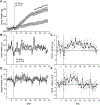Bidirectional effects of estradiol on the control of water intake in female rats
- PMID: 34020111
- PMCID: PMC8277715
- DOI: 10.1016/j.yhbeh.2021.104996
Bidirectional effects of estradiol on the control of water intake in female rats
Abstract
The inhibitory effect of estradiol (E2) on water intake has been recognized for 50 years. Despite a rich literature describing this phenomenon, we report here a previously unidentified dipsogenic effect of E2 during states of low fluid intake. Our initial goal was to test the hypothesis that the anti-dipsogenic effect of E2 on unstimulated water intake is independent of its anorexigenic effect in female rats. In support of this hypothesis, water intake was reduced during estrus, compared to diestrus, when food was present or absent. Water intake was reduced by E2 in ovariectomized rats when food was available, demonstrating a causative role of E2. Surprisingly, however, when food was removed, resulting in a significant reduction in baseline water intake, E2 enhanced drinking. Accordingly, we next tested the effect of E2 on water intake after an acute suppression of intake induced by exendin-4. The initial rebound drinking was greater in E2-treated, compared to Oil-treated, rats. Finally, to reconcile conflicting reports regarding the effect of ovariectomy on water intake, we measured daily water and food intake, and body weight in ovariectomized and sham-operated rats. Predictably, ovariectomy significantly increased food intake and body weight, but only transiently increased water intake. Together these results provide further support for independent effects of E2 on the controls of water and food intake. More importantly, this report of bidirectional effects of E2 on water intake may lead to a paradigm shift, as it challenges the prevailing view that E2 effects on fluid intake are exclusively inhibitory.
Keywords: Drinking microstructure; Estrogens; Food intake; Ovariectomy.
Copyright © 2021 Elsevier Inc. All rights reserved.
Figures






Similar articles
-
The estrogenic reduction in water intake stimulated by dehydration involves estrogen receptor alpha and a potential role for GLP-1.Physiol Behav. 2024 Mar 15;276:114484. doi: 10.1016/j.physbeh.2024.114484. Epub 2024 Feb 6. Physiol Behav. 2024. PMID: 38331374 Free PMC article.
-
Estrogen Receptor Beta Mediates the Dipsogenic Effect of Estradiol in Ovariectomized Female Rats.Neuroendocrinology. 2023;113(9):930-942. doi: 10.1159/000530962. Epub 2023 May 12. Neuroendocrinology. 2023. PMID: 37232025
-
Activation of membrane-associated estrogen receptors decreases food and water intake in ovariectomized rats.Endocrinology. 2013 Jan;154(1):320-9. doi: 10.1210/en.2012-1858. Epub 2012 Nov 26. Endocrinology. 2013. PMID: 23183173 Free PMC article.
-
Effects of a brain-enhanced chemical delivery system for estradiol on body weight and food intake in intact and ovariectomized rats.Pharm Res. 1989 Jul;6(7):592-600. doi: 10.1023/a:1015953431333. Pharm Res. 1989. PMID: 2798308
-
The anti-dipsogenic and anti-natriorexigenic effects of estradiol, but not the anti-pressor effect, are lost in aged female rats.Physiol Rep. 2021 Jul;9(14):e14948. doi: 10.14814/phy2.14948. Physiol Rep. 2021. PMID: 34288542 Free PMC article.
Cited by
-
Fluid transitions.Neuropharmacology. 2024 Sep 15;256:110009. doi: 10.1016/j.neuropharm.2024.110009. Epub 2024 May 31. Neuropharmacology. 2024. PMID: 38823577 Review.
-
The estrogenic reduction in water intake stimulated by dehydration involves estrogen receptor alpha and a potential role for GLP-1.Physiol Behav. 2024 Mar 15;276:114484. doi: 10.1016/j.physbeh.2024.114484. Epub 2024 Feb 6. Physiol Behav. 2024. PMID: 38331374 Free PMC article.
-
The role of glucagon-like peptide-1 (GLP-1) in fluid and food intakes in vasopressin-deficient Brattleboro rats.Physiol Behav. 2023 Apr 1;262:114093. doi: 10.1016/j.physbeh.2023.114093. Epub 2023 Jan 24. Physiol Behav. 2023. PMID: 36706972 Free PMC article.
-
Sex Differences in Salt Appetite: Perspectives from Animal Models and Human Studies.Nutrients. 2023 Jan 1;15(1):208. doi: 10.3390/nu15010208. Nutrients. 2023. PMID: 36615865 Free PMC article. Review.
-
Delayed but not immediate effects of estrogen curtail gamma-aminobutyric acid-mediated feeding responses elicited from the nucleus accumbens shell.Behav Neurosci. 2022 Jun;136(3):219-229. doi: 10.1037/bne0000511. Epub 2022 Apr 7. Behav Neurosci. 2022. PMID: 35389677 Free PMC article.
References
-
- Antunes Rodrigues J, Covian MR, 1963. Hypothalamic Control of Sodium Chloride and Water Intake. Acta physiologica latino americana 13, 94–100. - PubMed
-
- Asarian L, Geary N, 2002. Cyclic estradiol treatment normalizes body weight and restores physiological patterns of spontaneous feeding and sexual receptivity in ovariectomized rats. Hormones and behavior 42, 461–471. - PubMed
-
- Becker JB, Arnold AP, Berkley KJ, Blaustein JD, Eckel LA, Hampson E, Herman JP, Marts S, Sadee W, Steiner M, Taylor J, Young E, 2005. Strategies and methods for research on sex differences in brain and behavior. Endocrinology 146, 1650–1673. - PubMed
-
- Blaustein JD, Wade GN, 1976. Ovarian influences on the meal patterns of female rats. Physiology & behavior 17, 201–208. - PubMed
Publication types
MeSH terms
Substances
Grants and funding
LinkOut - more resources
Full Text Sources
Other Literature Sources

